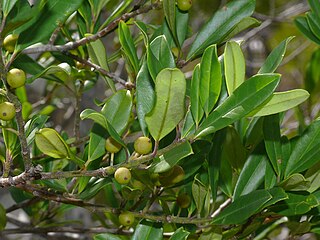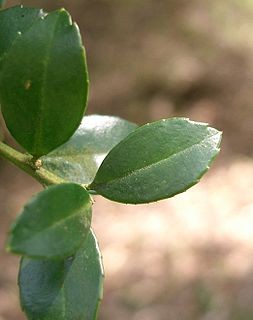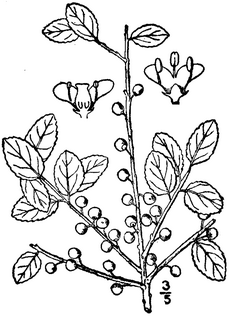
Yerba mate is a species of the holly genus (Ilex), with the botanical name Ilex paraguariensis A. St.-Hil., named by the French botanist Auguste François César Prouvençal de Saint-Hilaire.

Quercus ilex, the evergreen oak, holly oak or holm oak, is a large evergreen oak native to the Mediterranean region. It takes its name from holm, an ancient name for holly. It is a member of the Cerris section of the genus, with acorns that mature in a single summer.

Ilex opaca, the American holly, is a species of holly, native to the eastern and south-central United States, from coastal Massachusetts south to central Florida, and west to southeastern Missouri and eastern Texas.

Ilex cassine is a holly native to the southeastern coast of North America, in the United States from Virginia to southeast Texas, in Mexico in Veracruz, and in the Caribbean on the Bahamas, Cuba, and Puerto Rico. It is commonly known as dahoon holly or cassena, the latter derived from the Timucua name for I. vomitoria.

HMS Ilex was one of nine I-class destroyers destroyer built for the Royal Navy during the 1930s. She is the only ship of the Royal Navy ever to have been named after Ilex, the genus of flowering plants commonly known as holly.

Ilex vomitoria, commonly known as yaupon or yaupon holly, is a species of holly that is native to southeastern North America. The word yaupon was derived from its Catawban name, yopún, which is a diminutive form of the word yop, meaning "tree". Another common name, cassina, was borrowed from Timucua. The Latin name comes from an incorrect belief by Europeans that the plant caused vomiting in certain ceremonies.

Ilex verticillata, the winterberry, is a species of holly native to eastern North America in the United States and southeast Canada, from Newfoundland west to Ontario and Minnesota, and south to Alabama.

Black drink is a name for several kinds of ritual beverages brewed by Native Americans in the Southeastern United States. Traditional ceremonial people of the Yuchi, Caddo, Chickasaw, Cherokee, Choctaw, Muscogee and some other Indigenous peoples of the Southeastern Woodlands use the black drink in purification ceremonies. It was occasionally known as white drink because of the association of the color white with peace leaders in some Native cultures in the Southeast.

Ilex crenata is a species of holly native to eastern China(Taiwan), Japan, Korea, and Sakhalin.

Ilex aquifolium, is a species of holly native to western and southern Europe, northwest Africa, and southwest Asia. It is regarded as the type species of the genus Ilex, which by association is also called "holly". It is an evergreen tree or shrub found, for example, in shady areas of forests of oak and in beech hedges. In the British Isles it is one of very few native evergreen trees. It has a great capacity to adapt to different conditions and is a pioneer species that repopulates the margins of forests or clearcuts.

Ilex mucronata, the mountain holly or catberry, is a species of holly native to eastern North America, from Newfoundland west to Minnesota, and south to Maryland and West Virginia.

Ilex guayusa is a species of tree of the holly genus, native to the Amazon Rainforest. One of three known caffeinated holly trees, the leaves of the guayusa tree are dried and brewed like a tea for their stimulative effects.

Kuding or ku ding is a particularly bitter-tasting Chinese infusion, which due to their similarities in appearance is derived from several plant species. The two most common plants used to make kuding are the wax tree species Ligustrum robustum and the holly species Ilex kaushue, the former being more commonly grown in Sichuan and Japan while the latter is most commonly grown and used in the rest of China. This type of tea may be caffeinated if from the genus Ilex, but is caffeine-free if from the genus Ligustrum.

Ilex glabra, also known as Appalachian tea, dye-leaves, evergreen winterberry, gallberry, and inkberry, is a species of evergreen holly native to the coastal plain of eastern North America, from coastal Nova Scotia to Florida and west to Louisiana where it is most commonly found in sandy woods and peripheries of swamps and bogs. Ilex glabra is often found in landscapes of the middle and lower East Coast. It typically matures to 5–8 ft (1.5–2.4 m) tall, and can spread by root suckers to form colonies. It normally is cultivated as an evergreen shrub in USDA zones 6 to 10.

Ilex decidua is a species of holly native to the United States.

Ilex latifolia is a species of holly, native to southern Japan and eastern and southern China, growing in broadleaf forests at altitudes of 200–1,500 m.

Ilex, or holly, is a genus of about 480 species of flowering plants in the family Aquifoliaceae, and the only living genus in that family. The species are evergreen or deciduous trees, shrubs, and climbers from tropics to temperate zones worldwide.

Ilex mitis is a tall, dense, evergreen tree that is indigenous to Southern Africa. It makes an excellent fast-growing hedge for gardens - growing tall, straight and dense.

Ilex rotunda, commonly called the Kurogane holly, is an evergreen tree in the holly family (Aquifoliaceae). It is native to east Asia, where it is found in China, Japan, Korea, Taiwan, and Vietnam. Its natural habitat is in evergreen broadleaf forests, often in sunny areas such forest edges or on mountain slopes.






















